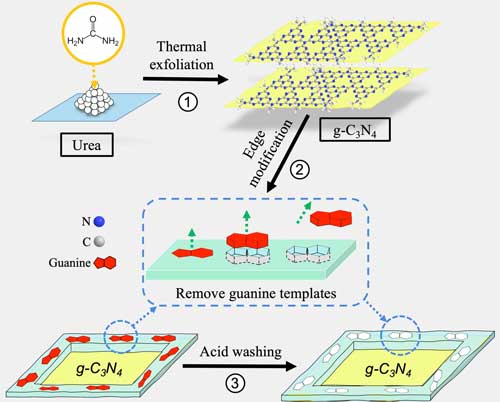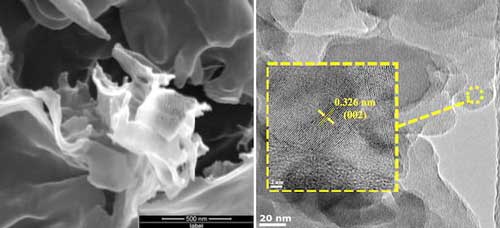| Mar 12, 2020 | |
New nano strategy fights superbugs(Nanowerk News) It’s not enough to take antibiotic-resistant bacteria out of wastewater to eliminate the risks they pose to society. The bits they leave behind have to be destroyed as well. |
|
| Researchers at Rice University’s Brown School of Engineering have a new strategy for “trapping and zapping” antibiotic resistant genes, the pieces of bacteria that, even though theirs hosts are dead, can find their way into and boost the resistance of other bacteria. | |
 |
|
| A schematic shows the three-step method to produce molecular-imprinted graphitic carbon nitride nanosheets. The process developed by Rice University researchers could help catch and kill free-floating antibiotic resistant genes found in secondary effluent produced by wastewater plants. (Illustration by Danning Zhang/Rice University) (click on image to enlarge) | |
| The team led by Rice environmental engineer Pedro Alvarez is using molecular-imprinted graphitic carbon nitride nanosheets to absorb and degrade these genetic remnants in sewage system wastewater before they have the chance to invade and infect other bacteria. | |
| The researchers targeted plasmid-encoded antibiotic-resistant genes (ARG) coding for New Delhi metallo-beta-lactamase 1 (NDM1), known to resist multiple drugs. When mixed in solution with the ARGs and exposed to ultraviolet light, the treated nanosheets proved 37 times better at destroying the genes than graphitic carbon nitride alone. | |
| The work done under the auspices of the Rice-based Nanosystems Engineering Research Center for Nanotechnology-Enabled Water Treatment (NEWT) is detailed in the American Chemical Society journal Environmental Science and Technology ("Selective Adsorption and Photocatalytic Degradation of Extracellular Antibiotic Resistance Genes by Molecular-Imprinted Graphitic Carbon Nitride"). | |
| “This study addresses a growing concern, the emergence of multidrug resistant bacteria known as superbugs,” said Alvarez, director of the NEWT Center. “They are projected to cause 10 million annual deaths by 2050. | |
| “As an environmental engineer, I worry that some water infrastructure may harbor superbugs,” he said. “For example, a wastewater treatment plant in Tianjin that we’ve studied is a breeding ground, discharging five NDM1-positive strains for each one coming in. The aeration tank is like a luxury hotel where all bacteria grow. | |
| “Unfortunately, some superbugs resist chlorination, and resistant bacteria that die release extracellular ARGs that get stabilized by clay in receiving environments and transform indigenous bacteria, becoming resistome reservoirs. This underscores the need for technological innovation, to prevent the discharge of extracellular ARGs. | |
| “In this paper, we discuss a trap-and-zap strategy to destroy extracellular ARGs. Our strategy is to use molecularly imprinted coatings that enhance selectivity and minimize interference by background organic compounds.” | |
| Molecular imprinting is like making a lock that attracts a key, not unlike natural enzymes with binding sites that only fit molecules of the right shape. For this project, graphitic carbon nitride molecules are the lock, or photocatalyst, customized to absorb and then destroy NDM1. | |
 |
|
| At left, a scanning electron microscope image shows the mesoporous structure of molecular-imprinted graphitic carbon nitride nanosheets. At right, a transmission electron microscope image shows the sheet’s edge and its crystalline structure. Rice University researchers imprinted the nanosheets to catch and kill free-floating antibiotic resistant genes found in secondary effluent produced by wastewater plants. (Image: Alvarez Research Group/Rice University) | |
| To make the catalyst, the researchers first coated the nanosheet edges with a polymer, methacrylic acid, and embedded guanine. “Guanine is the most readily oxidized DNA base,” Alvarez said. “The guanine is then washed with hydrochloric acid, which leaves behind its imprint. This serves as a selective adsorption site for environmental DNA (eDNA).” | |
| Rice graduate student Danning Zhang, co-lead author of the paper, said carbon nitride was chosen for the base nanosheets because it is nonmetallic and is thus safer to use, and for its easy availability. | |
| Alvarez noted all catalysts are efficient at removing ARGs from distilled water, but not nearly as effective in secondary effluent, a product of sewage treatment plants after solids and organic compounds are removed. | |
| “In secondary effluent, you have reactive oxygen species scavengers and other inhibitory compounds,” Alvarez said. “This trap-and-zap strategy significantly enhances removal of the eDNA gene, clearly outperforming commercial photocatalysts.” | |
| The researchers wrote that conventional disinfection processes used at wastewater treatment plants, including chlorination and ultraviolet radiation, are moderately effective in removing antibiotic-resistant bacteria but relatively ineffective at removing ARGs. | |
| They hope their strategy can be adapted on an industrial scale. | |
| Zhang said the lab has not yet run extensive tests on other ARGs. “Since guanine is a common constituent of DNA, and thus ARGs, this approach should also efficiently degrade other eARGs,” he said. | |
| There is room to improve the current process, despite its extraordinary initial success. “We have not yet attempted to optimize the photocatalytic material or the treatment process,” Zhang said. “Our objective is to offer proof-of-concept that molecular imprinting can enhance the selectivity and efficacy of photocatalytic processes to target eARGs.” |
| Source: Rice University | |
|
Subscribe to a free copy of one of our daily Nanowerk Newsletter Email Digests with a compilation of all of the day's news. |
